Sheshenq I... the Amazigh who seized the throne of the Pharaohs
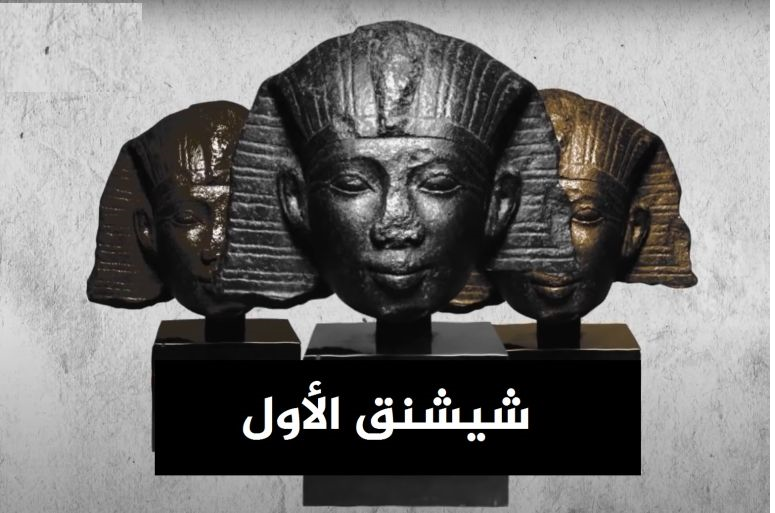
In the first weeks of the year 2021, the name of the Pharaonic king Sheshenq I (his name is written in different ways, including Sheshenq), sparked great controversy among the peoples of Algeria, Egypt, and Libya, because each of them considered that he descended from their country.
The controversy began after the announcement of the erection of a statue of Sheshenq in the Algerian city of Tizi Ouzou as an Amazigh king, to which some Egyptian commentators responded, considering this a theft of Egyptian history and culture, considering Sheshenq an Egyptian Pharaonic king belonging to what is known as the Libyan family in the Pharaonic period.
Libya was not late in getting on the line, as the Libyan Government of National Accord was quick to issue an official statement in which it considered Sheshenq to be purely Libyan and had no connection to any other country.. So what is the story of this Amazigh Pharaoh?
“Berber Academy”... adopting Berber history in honor of the Pharaoh
The inauguration of the statue of King Sheshenq took place in the Algerian city of Tizi Ouzou at the beginning of 2021, coinciding with the local celebrations of what is known as the Amazigh New Year, which falls on January 12.
After causing major debates on social networks, the ceremony attracted a large number of citizens coming from various states of Algeria, led by political leaders, in addition to the sculptor artists Hamid Ferdi and Salmi Samir, who completed the 4.4-meter-long statue of Sheshenq I, with funding from the State People’s Council amounting to six million dinars. Algerian (one dollar equals approximately 133 dinars).
Local officials of this celebration considered that choosing the Amazigh New Year to inaugurate this statue was a way to honor Sheshenq. A reminder of a glorious page in the history of Algeria and all of North Africa. While many historians link the beginning of the Berber calendar - which reached the year 2971 at the beginning of the year 2021 AD - with the arrival of Sheshenq to the throne of Pharaonic rule in Egypt, in the year 950 BC, as this king is considered the founder of what is known as the 22nd Pharaonic Dynasty.
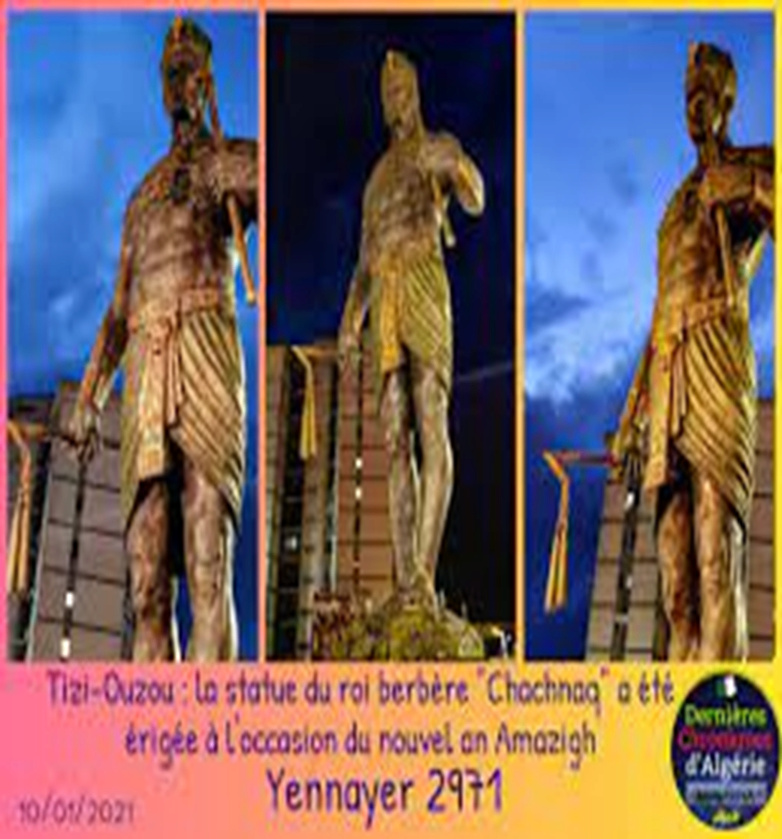
The adoption of this Amazigh calendar began in the seventies of the twentieth century by an Amazigh association bearing the name “Berber Academy,” which was founded in 1966 in France by a group of academics. This body considered the year 950 BC to be the beginning of this calendar, which coincides with the beginning of the reign of King Sheshenq. In Pharaonic Egypt.
This Algerian celebration of the erection of the statue of Sheshenq I sparked a storm of debate on social networks. Egyptian bloggers and activists considered the move to be a theft of their country’s history, and some of them launched a campaign on Twitter using the hashtag “Shishang_Egyptian,” calling on the Egyptian authorities to address their Algerian counterparts in this regard.
Chief leader of the Meshwash.. Libya proves the lineage of its immigrant son
The country that mediates Egypt and Algeria did not remain immune from this debate, as the Libyan General Authority for Culture, affiliated with the Government of National Accord, issued a statement in which it presented Libya’s story, and said that it had adopted a scientific reference with a high degree of accuracy and credibility, to conclude that King Sheshenq I was of Berber origins. Libyan, specifically from the Libyan Meshwash tribe, and his family, known as “Dynasty 22,” is nicknamed “the Libyan family” by those interested in ancient Egyptian history.
The Ministry of Culture in the Libyan Government of National Accord said that it is preparing to issue a report on King Sheshnak I, in cooperation with a number of researchers and historians, describing him as a Libyan personality.
As for the Egyptian archaeologist Zahi Hawass, he said that despite the Libyan origins of Pharaoh Sheshenq I, he is Egyptian through his fifth grandfather. He explained that the Egyptian origins of King Sheshenq go back to his family of Libyan origin, which settled in the city of Tell Basta (also called Bubasta) in Zagazig (Delta of Egypt), and they migrated to Egypt in the period between 1580-1307 BC, that is, centuries before the birth of Sheshenq, and that the priests of Thebes (The highest religious body in ancient Egypt) They called him the chief leader of the Mashwash.
The matter was not limited to the three aforementioned countries, but the debate extended to Tunisia, as local activists tweeted that the Pharaonic king -Who some believe defeated the Pharaonic King Ramesses and seized his rule - Tunisian in origin.
New Year's celebrations... debates about culture, religion and history
Just as it ignited a heated debate in politics and social media, the statue of Chesshenq in the Algerian city of Tizi Ouzou also sparked religious debates, including those related to the dispute over the permissibility of celebrating the Amazigh New Year or not, as some publish fatwas prohibiting this, while others consider it a cultural and historical matter. It does not touch on religion, while some writings say that King Sheshenq is mentioned in the heavenly books, including the Torah and the Gospel.
The debate is not limited to the historical aspect, but extends to the religious field, where it raises celebrations and rituals specific to the Amazigh calendar Les réserves de certains issus d’un milieu religieux envisagent la question sous l’angle des hérésies et des questions étrangères à l’Islam.
La fatwa la plus importante revenue sur le devant de la scène grâce à la statue de Sheshenq est une fatwa émise par Muhammad Ali Farkous, le cheikh salafiste le plus éminent d'Algérie en 2006, stipulant qu'il n'est pas permis de célébrer le « janvier », c'est-à-dire le Nouvel An Amazigh.

Cette fatwa dit que la célébration de cette occasion est similaire aux fêtes de l'époque préislamique, et que l'Islam l'a remplacée par seulement deux fêtes : l'Aïd al-Fitr et l'Aïd al-Adha. Tandis que certains chefs religieux répondent que cette fatwa découle d'une vision étroite de la religion et de ses dimensions, et que la question est liée à un héritage culturel des Algériens qui crée de la joie et du bonheur et est propice au maintien des liens familiaux. À l'heure où certains remettent en question la validité des récits qui parlent de certaines figures et symboles amazighs, et où il existe des affirmations contradictoires qui confirment le lien du calendrier amazigh avec des phénomènes naturels et agricoles, contre d'autres qui le lient à la prétendue victoire de Sheshenq sur le pharaon égyptien ; Quelle que soit la véracité de ces récits, il y a ceux qui les défendent parce que tous les peuples ont besoin des mythes qui établissent leur existence et leur entité, y compris les peuples amazighs, qui ont le droit de glorifier ceux qu'ils considèrent comme leurs grands hommes et d'enseigner à leurs enfants. pour s’en inspirer, des valeurs humaines haut de gamme fondées sur la liberté et les droits.

L'inauguration de la statue du roi Sheshenq dans la ville algérienne de Tizi Ouzou début 2021, coïncidant avec les célébrations du Nouvel An amazigh.
Les ancêtres du Pharaon d'Argent... alliés aux Peuples de la Mer contre les Pharaons The world learned scientifically for the first time about King Sheshenq in 1940, after the French professor “Pierre Monte” was able to discover his tomb. It was found with all its treasures and was not looted, and due to the size of the silver found in his tomb, he was called the Silver Pharaoh.
The Sheshonq family is of Libyan origin, and includes a group of wealthy people who settled in the city of Ihnasia, located in Beni Suef Governorate, but they gradually extended their influence as far as Fayoum.

This family represents what resembles a “military dictatorship” in present-day language. The Meshwash Libyan fighters succeeded in having most of the units of the Pharaonic army restricted to them alone, and their leaders enjoyed great influence because the country was in a state of political, military and economic collapse, and it was divided into several kingdoms. They came to represent military power, and they exploited this superiority in order to control the throne.
Some historical sources confirm that the tribal structure from which Sheshenq descended often tried to control Egypt through military force. They united with the Sea Peoples (a name given by historical scholars to the peoples who attacked the coasts of Egypt and Libya coming from the Mediterranean Sea) and attacked Egypt, but they were not able to They were allowed to remain on its land, then they returned again in the eleventh year of the rule of Ramesses III, and the Pharaoh defeated them on his borders, but that did not prevent them from entering Egypt peacefully, and they included a mixture of the ancient people of the Western Sahara and groups of sea peoples who had settled on the coast of Libya since Late thirteenth century BC
The Meshwash entered the land of Egypt as shepherds, merchants, or mercenaries in the army, and their tribes settled since the end of the reign of Ramesses III on the agricultural outskirts of Egypt, and around the forts spread on the western borders. Then they gradually Egyptianized and worshiped the Egyptian gods, and groups of them entered the Egyptian military garrisons, and were granted some agricultural lands as salaries. They received them in exchange for their service in the army, which contributed to the increase in the influence of these Libyans.

The Sheshenq people entered the army as mercenaries and were given some agricultural lands as salaries in exchange for their service, which contributed to the increase in their influence.
“Big King Ma”...a plan to break through norms to seize power
The circumstances that Egypt was going through at that time helped the Meshwash enjoy a lot of influence in their communities, which were characterized by a military character, most notably those who lived in the oases, and then migrated to Ihnasia in the latter days of the Ramses (plural of Ramesses), from which Sheshenq would become. The first was the founder of the Twenty-Second Dynasty.
Before they seized power in Ihnasia, the Meshwash, to which Sheshenq belonged, had already become Egyptians, and after they were only chiefs and military commanders, their chief bore the title “Ma” or “Great King Ma,” which is an abbreviation for Meshwash, and by bearing this religious title, they They also became priests of the Egyptian temple “Hari Shef”, and they now have the full right to be buried like Egyptians. The family’s power will increase later, and from Ehnasia they will extend their control to “Tel Basta”. Which they will take as the capital of the Twenty-Second Dynasty.

The long stay of the Libyans in Egypt taught them how to seize power without popular resistance, by being very careful about local political and religious traditions inherited from the oldest historical eras.
At the beginning, Sheshenq did not possess any of the qualifications to ascend to the throne, as he had no royal blood running through his veins and was not linked to an in-law relationship with the Pharaonic family, but he solved this problem by marrying his son to a princess who was the daughter of the last Pharaoh king, which helped him control reins of government.
What indicates Sheshenq’s power, wealth, and position in society before he assumed power is that at the end of the Twenty-First Dynasty, one of his sons died and was buried, then an attack occurred on his tomb, so Sheshenq went and complained to the Pharaoh. He took care of the matter and took him to Thebes to hear the ruling of “Amun Ra” on that matter. The trial was held in the Temple of Amun in Karnak in front of the Pharaoh and the High Priest, and it ended with the conviction of the perpetrators. Then the Pharaoh bowed before the statue of the god, and asked him to bless all of Sheshenq’s actions, and he sent tribute to him. A picture of a statue in the name of Sheshenq’s father.
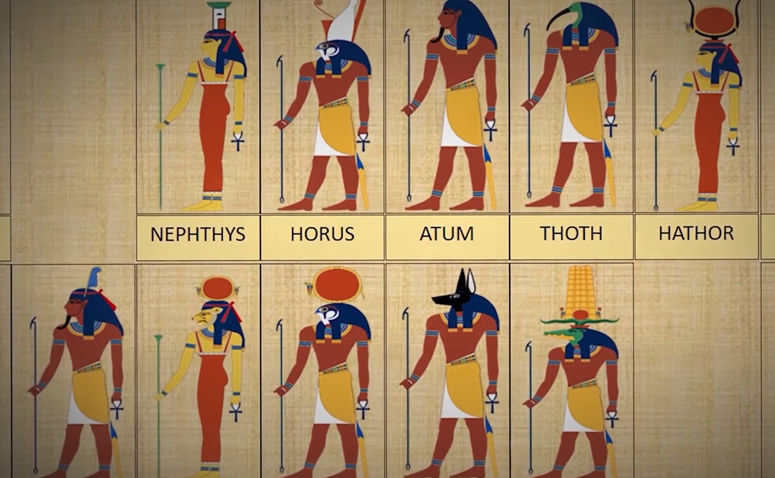
Sheshenq I belonged to the 22nd Pharaonic family that ruled Egypt for two centuries
The keys to Egypt are in the hands of an elderly man in his fifties... a quiet coup
Sheshenq became very wealthy before assuming power, and went to live in Bu Basta, where his son Osorkon married Princess Maat Kare, the king’s daughter and the legal heiress. It seems that the transfer of power to Sheshenq took place quietly, and that when he was fifty years old, he did not stage a revolution to depose Psusennes II, but rather waited until his death, then advanced and seized the throne.
The Sheshenq family sat on the throne of the Pharaohs, and took Bou Basta as its capital. Then, Ihnasia became the seat of the ancient Sheshenq family, a feudal lord of a branch of the family that took over its civil and religious affairs. As for Upper Egypt, Sheshonq was not recognized as king of Egypt for a while, then he returned and accepted the fait accompli, and here some of the Theban priests left all of Egypt, not wanting to submit to rulers of Libyan origin, and headed to the outskirts of the southern Egyptian border, where a new family was ruling in Nabata at The foot of Jebel Barkal.
It is known that Thebes and most of the regions of Upper Egypt were, during the Twenty-First Dynasty, a state within a state, headed by a priestly family bearing military titles. Hence, Sheshenq I worked to consolidate the country’s unity by two means: It is the appointment of some members of the royal house and their supporters to head the major administrations in the priesthood of Amun in Thebes, and the second method is the continuous marriage of the daughters of the priestly family in Thebes.
Sheshenq appointed his son Iu-Bot to the position of high priest of “Amun-Ra” in Karnak, breaking the previously accepted tradition of inheritance for this position, which was fraught with dangers, because the high priests of Amun were not only priests, but they were also men of war, and Sheshenq was able to do so. To empower his family with both political and spiritual power, and this led to the association of divination with kingship.
Instead of including the independent government of Thebes into his government in his new capital, Bou Basta, Sheshenq contented himself with installing one of his sons as high priest, a religious position that also meant possession of political power. This restored the country's unity, as both the religious government of Thebes and the worldly government of Bu Basta became in the hands of the same family. Immediately after completing this unification process, Sheshonq turned his attention abroad, as he had a strong desire to restore the glories of Egypt in both West Asia and Sudan, which was achieved through his campaign against Palestine.

Sheshenq installed one of his sons as high priest, a religious position that meant the possession of political power
Secrets of the Pharaonic court... paving the way to military dictatorship
Sheshenq did not have to depose Pharaoh Ramesses, or Psussan, as some call him, who was the last king of the 21st Pharaonic dynasty, nor did he carry out a bloody coup against him, as some imagine. Rather, he contented himself with waiting for his death after he had managed to establish the state and control it, benefiting in this from his proximity to the Pharaonic court and his knowledge of its secrets.
Sheshonq realized from the beginning that his only path to power was to win minds and hearts, through the religious card in which he benefited from the ancient religious heritage of his family. His father inherited from his grandfathers the high priesthood in Thebes, and he held the title of the High Priest. Thus, Sheshonq advanced with full confidence after the death of the pharaoh, and assumed the reins of power without the slightest resistance, establishing the Pharaonic Dynasty 22 with the help of the rulers of the Temple of Amun.
Some researchers explain the effects of the wars and unrest that occurred at the beginning of Sheshenq’s rule, by the military dictatorship that he brought, and not by his conflict with the Twenty-First Pharaonic Dynasty. . However, historical sources acknowledge the difficulty of ascertaining the extent of the widespread rebellion of Egyptians who rejected this foreign presence that affected the throne, although it is likely that Thebes and its environs were the main center of Egyptian tension against Sheshenq and his policy.
Invasion of the country of Judah.. The victory of the Pharaohs over Jerusalem
Sheshenq ascended the throne of Egypt while it was exhausted, and its neighbors in the East were growing increasingly greedy for its possessions in Asia, which it had gained since the days of glory. These greedy neighbors began to compete with Egypt in the field of trade. These circumstances explain why the reign of this Libyan-Egyptian pharaoh was characterized by foreign wars, most notably His military campaign led him to Palestine and the Levant, although historical sources are unable to determine the reason for this military move that occurred immediately after the death of the Prophet and King Solomon, peace be upon him. The most prominent feature that distinguished the rule of the Berber king Sheshnak was his attack on the land of Judah during the reign of King Rehoboam, who succeeded his father Solomon, peace be upon him, and his victorious entry into Jerusalem.
A historical incident about which many details are mentioned in written sources, most notably the Torah in the part called “The Second Chronicles,” where some consider that Sheshenq was one of the reformers who performed noble tasks, like other well-known figures in Islamic references, such as Dhul-Qarnayn and Al-Khidr. Sources talk about a good friendly relationship between Sheshenq and the Prophet of God, King Solomon, before his death.
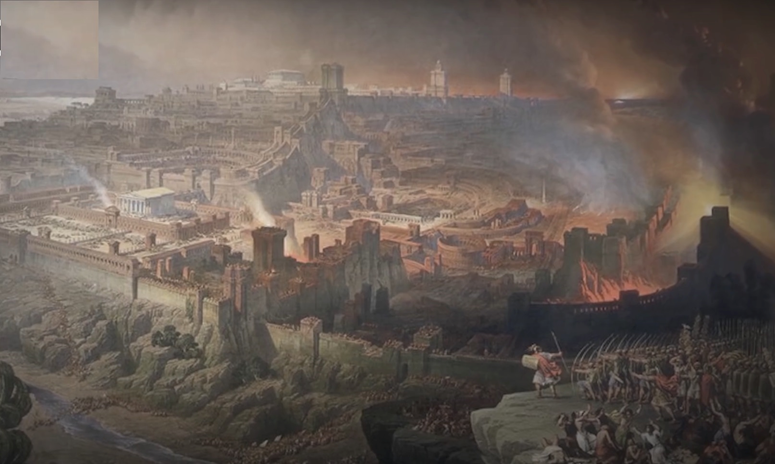
Sheshonq led a campaign against Palestine and the Levant, in which he extended his control over them
Tearing apart the kingdom of the Prophet Solomon...the return of the king with prisoners and victory
The researchers - who tried to scrutinize the events of this historical stage - summarize the reasons for Sheshenq’s campaign against Palestine and the Levant in main reasons, including his effort to revive the glories of Egypt in Western Asia, and his attempt to establish the throne of Jeroboam among the children of Israel. He fled to Egypt to escape from Solomon, and was welcomed and promised. With the support of Sheshonq, he then returned to his land after the death of Solomon, and when the northern tribes of Israel disagreed with the southern ones and separated into the states of Israel and Judah, the northerners chose him as king of Israel.
It is also possible that the motive behind this campaign was the search for spoils and resources that was common at the time, and it is not unlikely that the motive was Sheshenq’s quest for revenge against the tribes of Judah bordering the eastern delta, because they were involved in border skirmishes. In addition to the written historical sources that talk about this military campaign - including the Torah - when Sheshenq returned to Egypt, he recorded the story of his victory in a painting on the facade of the southern part of the second pylon in the Karnak Temple, and the king appears in a view above the heads of the prisoners from the second pylon in Karnak Temple presenting them to the god Amun.

These prisoners represent the people of 156 Palestinian cities located on the southern borders of the land of Judah and northern Galilee. In order to make it easier to approach these inscriptions that cover the walls, Sheshonq built a main gate in Karnak, located between the second pylon and the temple of Ramesses III, and it is known today as the “Bastet Gate,” and a road passes underneath it that leads to these inscriptions. . While historical sources do not know whether Sheshonq carried out another campaign after that in northern Palestine or not, they prove that he died about one year after his campaign to Palestine.
The fight of strangers for independence and prestige... the authority of Egypt over the usurpers
While the reigns of rulers of Libyan origins lasted more than two centuries, starting with the rule of Sheshenq, scientific research has confirmed that during this long period they forgot their origin, which was foreign to Egypt, and did not mention about themselves except that they were Egyptian pharaohs, so they fought in the name of Egypt outside its borders, and tried to restore some of it to it. Its old reputation and prestige.
Some historians liken the eras of these rulers of Libyan origin to the eras of the Egyptianized Mamluks, whom history did not consider as foreigners as much as it considered them usurpers, and they were not able to influence the Egyptian spirit as much as they were influenced by it. Their usurpation of the country’s throne did not prevent a number of reformist rulers from appearing among them, nor did their foreign origin prevent them from being loyal to it and its independence.
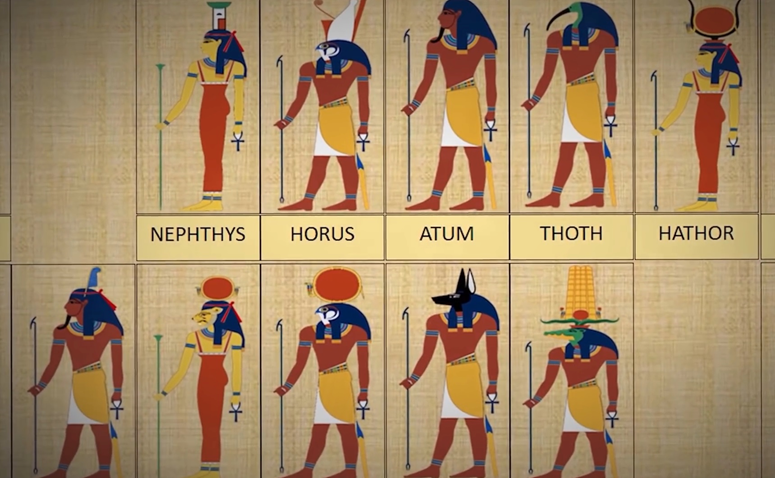
The similarity between the rule of the Libyan kings of Egypt and the rule of the Mamluks is evident in the fact that these and those entered the country to serve the king and participate with him in waging wars against the enemies of Egypt, and after their authority was strengthened and they seized control of many of the country’s facilities, they began working in secret to weaken the king and withdraw power from him little by little. Until the time came and they jumped to the king's throne without much trouble or violent resistance.
The Canadian mummy...the remains of the short octogenarian king’s body Estimates of the age at which Sheshenq died range between 70 and 80 years, while it has been scientifically confirmed that he was buried in the royal cemetery in Tanis, where two coffins were found inside the main burial chamber in one of the cemetery’s tombs, one of which likely belonged to Sheshenq. The discovery of the tomb of King Sheshenq goes back to a French archaeological mission specializing in ancient Egyptian history, which made its historic discovery in 1939.
Although the king's mummy was not found in the cemetery, the mummy is preserved in Canada and has been subjected to careful scientific research. It is likely that it belongs to Sheshenq, given the results of examinations to determine the era to which it belongs, and the quality of the mummification method that is consistent with the royal style.
After examining Sheshenq’s skeleton, scientists were able to determine his physical characteristics, including that his height was 1.66 cm, that he was of strong build, that his head was huge compared to his short body, that his right eye was higher than his left eye, and that he died at the age of 80 years.
Source: websites

